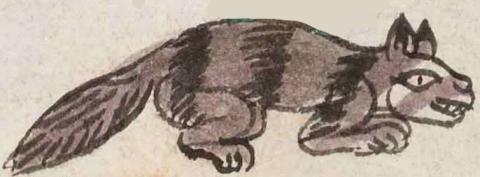epatl (Mdz22r)
This element has been carved from the compound glyph for the place name, Epazoyocan. The animal shown [the epatl) is meant to be a skunk. It has a purplish-gray color, but with white stripes on the head, three black stripes on the body, and a long bushy tail. It faces to our right, and crouches somewhat. Its ears stand up, its eye is open, and the mouth is slightly open, showing some white teeth.
Stephanie Wood
Contrary to possible expectations, there is no visible white stripe along the top of the animal's back. Furthermore, the direction of the stripes on this representation of the epatl run the opposite way that a skunk's stripes normally run, which is the length of the body. As shown in our online dictionary (cited elsewhere in this record), the when an epatl got into someone's house or gave birth there, it was an omen that one of the people in the house would die. It may be that not much attention was given to the epatl because it was a phonetic indicator, meant to tip off the reader to the fact that the herbs shown in the compound glyph were epazotl. This herb has a strong smell, which may be more than a coincidence.
Stephanie Wood
c. 1541, but by 1553 at the latest
Stephanie Wood

epa(tl), skunk, https://nahuatl.wired-humanities.org/content/epatl
skunk
el zorrillo
Stephanie Wood
Codex Mendoza, folio 22 recto, https://digital.bodleian.ox.ac.uk/objects/2fea788e-2aa2-4f08-b6d9-648c00..., image 54 of 188.
The Bodleian Libraries, University of Oxford, hold the original manuscript, the MS. Arch. Selden. A. 1. This image is published here under the UK Creative Commons, “Attribution-NonCommercial-ShareAlike 3.0 License” (CC-BY-NC-SA 3.0).

